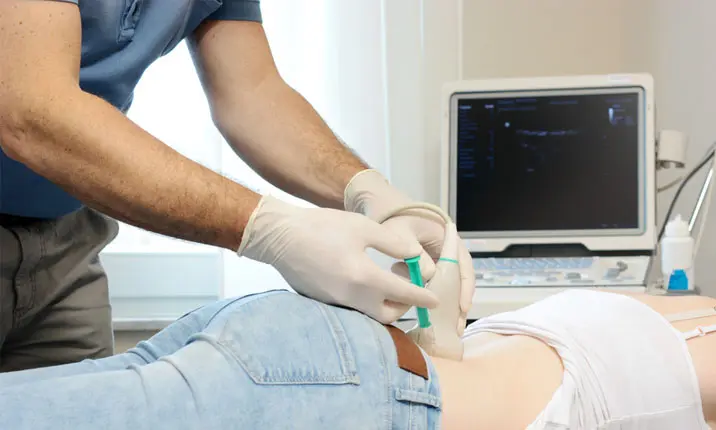
Sciatica pain is caused by pinching, inflammation, compression, or irritation of the lower back nerve. Self-care and exercise are generally required to treat this pain. In a few rare cases, surgery is required. Read this article to learn about sciatica treatment in Mumbai and the clinic for the best sciatica doctors in Mumbai.
It is a nerve pain caused by irritation or injury to the sciatic nerve, which emerges in your gluteal or buttock area. Your sciatic nerve is the thickest and longest nerve in the body. It comprises five nerve roots: two from the lower back part known as the lumbar spine and three from the spine’s final section known as the sacrum.
A true injury or irritation to the sciatic nerve is usually rare, but the term “sciatica” is often used to mark out any pain that occurs in your lower back and extends down the leg.
If you are dealing with sciatica pain, your pain varies from mild to severe around your buttocks, hips, or down to the legs. It can also lead to muscle weakness in your foot and leg and an annoying tingling sensation in your toes, foot, and legs.
Note : Sometimes, you can have a slipped disc without any signs or symptoms.
Initially, your doctor will take a look at your medical records. Next, they will talk about your symptoms.
In your physical test, your healthcare provider would ask you to walk so they could check out how your spine carries your body weight. You might be asked to walk on your heels and toes to determine the strength of your calf muscles.
A doctor might also do a leg-raise test. In this position, you will lie on your back with straight legs. The doctor will gently raise your leg and check the point at which your pain starts. This will help detect the affected nerves and check if there is an issue with your discs.

You might also be asked to move and stretch in different ways to check for pain and see how flexible and strong your muscles are.
Based on what your doctor discovers in your physical test, imaging and several other tests may be carried out. These might include:
The main motive of these treatments is to enhance mobility and decrease pain. Based on your cause, several sciatica cases fade away over time with a few self-care treatments.
First, apply ice packs to reduce swelling and pain. For the injured area, use an ice pack or a bag of frozen vegetables wrapped in a towel. Follow this for 20 minutes, multiple times a day. Switch to a heating pad or hot pack after a few days. Apply for the same 20 minutes. If you are still in pain, you can switch between the cold and hot packs, whichever eases your pain and discomfort.
Take these medications to reduce swelling, inflammation, and pain. Nonsteroidal anti-inflammatory drugs (NSAIDs) like naproxen, ibuprofen, and aspirin are some of the over-the-counter medicines in this section. Be careful if you take aspirin, as it can cause bleeding and ulcers in some patients. If you are not able to take NSAIDs, acetaminophen might work.
Learn the proper stretches for pain relief. Work up to doing different aerobic exercises, strengthening your core muscles, and strengthening your muscles all over.

The symptoms, causes, intensity, and pain of each sciatica patient are different. In a few patients, a more vigorous treatment might be tried first. Nonetheless, if self-care treatments have not helped you for 5 to 6 weeks, it’s time to consult a healthcare professional.
Your doctor might prescribe muscle relaxants, like Amrix or Flexeril, to ease your pain related to muscle spasms. Other medicines that help with pain relief might be tried, such as anti-seizure medications and tricyclic antidepressants. Based on your pain level, prescription pain drugs may be used initially in your treatment plan.
The goal of physiotherapy is to find an exercise that reduces sciatica pain by lowering pressure on your nerves. Stretching to make your muscles more flexible and aerobic exercises like water aerobics, swimming, and walking are all important parts of an exercise plan.
Your doctor can refer you to a physiotherapist, who will work with you to customize your aerobic exercise plan and stretches and suggest other workouts to strengthen your back, legs, and abdomen.
A corticosteroid injection in your lower back might help reduce pain and swelling in the nerve roots that are injured. This injection can offer short-term pain relief for up to 3 months and is injected under anesthesia.
You may feel some pressure and a stinging or burning sensation when the injection is administered. Talk to your healthcare provider about the risks related to this injection.
Alternative therapies are highly in demand and are used to manage and treat all types of pain. You can also get rid of sciatic pain with acupuncture, yoga, or spinal manipulation by a professional and experienced chiropractor. Massage may help your muscle spasms that frequently arise along with sciatica. Biofeedback is also an option to help relieve stress and manage pain.
Spinal surgery isn’t usually recommended unless other treatments like medications and exercises haven’t helped, your pain is getting worse, your lower back muscles are very weak, or you’ve completely lost control of your bowels or bladder.
The goal of spinal surgery is to take pressure off of nerves that are being pinched and make sure that your spine is stable.

This is a minimally invasive treatment that is usually used to take out pieces of a slipped or herniated disc that are pressing on a nerve.
In this treatment, the roof of your spinal canal—the lamina that is pressing on your sciatic nerve—is eliminated.
Reach out to us at One Spine Clinic to learn more about sciatica treatment in Mumbai. We have been offering care-driven and intelligent solutions for your spine problem.
We have a team of very skilled and experienced spine surgeons who can treat any kind of spinal problem with cutting-edge methods. If you are looking for the best sciatica doctor in Mumbai, you can feel free to contact us.